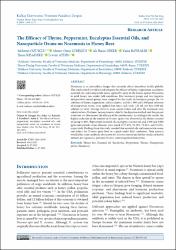| dc.contributor.author | Özüiçli, Mehmet | |
| dc.contributor.author | Girişgin, Ahmet Onur | |
| dc.contributor.author | Diker, Ali İhsan | |
| dc.contributor.author | Baykalır, Yasin | |
| dc.contributor.author | Kısadere, İhsan | |
| dc.contributor.author | Aydın, Levent | |
| dc.date.accessioned | 2024-05-10T06:44:58Z | |
| dc.date.available | 2024-05-10T06:44:58Z | |
| dc.date.issued | 2023 | en_US |
| dc.identifier.issn | 1300-6045 / 1309-2251 | |
| dc.identifier.uri | https://doi.org/10.9775/kvfd.2023.29167 | |
| dc.identifier.uri | https://hdl.handle.net/20.500.12462/14656 | |
| dc.description.abstract | Nosemosis is an intracellular fungus that seriously affects honeybees' health globally. This study aimed to evaluate and compare the efficacy of thyme, peppermint, eucalyptus essential oils, and nanoparticle ozone applied by spray on the frames against Nosemosis in adult honey bees under field conditions. Five treatment groups and two (negative and positive) control groups were assigned for this study. In treatment groups; the 3% solutions of thyme, peppermint, and eucalyptus, and the 1.000 and 2.000 ppm solutions of nanoparticle ozone, were applied four times each week, 125 mL per hive (500 mL solution in total). Average Nosema spore counts before and after the treatment were calculated on a Neubauer hemocytometer slide by the digestion method, and the percent reduction test determined the efficacy of the combinations. According to the results, the highest reduction in the number of Nosema spores was observed in the thyme essential oil group at 84%. Peppermint essential oil, eucalyptus essential oil, and 1.000 and 2.000 ppm nanoparticle ozone efficacies were found at 77.45%, 76.10%, 72.41%, and 71.21%, respectively. Findings from this study revealed that essential oils and nanoparticle ozone can reduce the Nosema spore load to a point under field conditions. Plant extracts would offer a non-antibiotic alternative for Nosema control and further studies of herbal extracts are required as potential Nosema control agents in honey bees. | en_US |
| dc.description.sponsorship | Balikesir University 2021/074 | en_US |
| dc.language.iso | eng | en_US |
| dc.publisher | Kafkas Univ.Veteriner Fakultesi Dergisi | en_US |
| dc.relation.isversionof | 10.9775/kvfd.2023.29167 | en_US |
| dc.rights | info:eu-repo/semantics/openAccess | en_US |
| dc.rights | Attribution-NonCommercial 4.0 International | * |
| dc.rights.uri | https://creativecommons.org/licenses/by-nc/4.0/ | * |
| dc.subject | Honey Bee | en_US |
| dc.subject | Essential Oil | en_US |
| dc.subject | Eucalyptus | en_US |
| dc.subject | Peppermint | en_US |
| dc.subject | Thyme | en_US |
| dc.subject | Nanoparticle Ozone | en_US |
| dc.subject | Nosemosis | en_US |
| dc.title | The efficacy of thyme, peppermint, eucalyptus essential oils and nanoparticle ozone on nosemosis in honey bees | en_US |
| dc.type | article | en_US |
| dc.relation.journal | Kafkas Universitesi Veteriner Fakultesi Dergisi | en_US |
| dc.contributor.department | Veteriner Fakültesi | en_US |
| dc.contributor.authorID | 0000-0003-3415-2582 | en_US |
| dc.contributor.authorID | 0000-0002-9248-6065 | en_US |
| dc.contributor.authorID | 0000-0003-0732-0464 | en_US |
| dc.contributor.authorID | 0000-0002-9248-6065 | en_US |
| dc.identifier.volume | 29 | en_US |
| dc.identifier.issue | 4 | en_US |
| dc.identifier.startpage | 335 | en_US |
| dc.identifier.endpage | 342 | en_US |
| dc.relation.publicationcategory | Makale - Uluslararası Hakemli Dergi - Kurum Öğretim Elemanı | en_US |



















